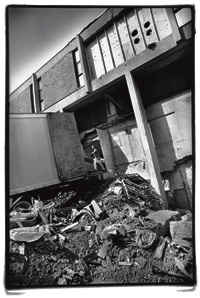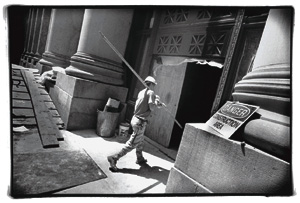![]()
Main Menu ·
Search ·
Current Issue · Contact · Archives · Centennial · Letters to the Editor · FAQs
![]()
Main Menu ·
Search ·
Current Issue · Contact · Archives · Centennial · Letters to the Editor · FAQs


|
 Racquets rising: The new athletic building took shape at the end of the stadium.Jim Harrison
Racquets rising: The new athletic building took shape at the end of the stadium.Jim Harrison |
Summer is the season for sprucing up Harvard--securing old bricks with new mortar, applying fresh paint to aged clapboards. More ambitiously, old buildings are razed and new ones raised.
Some of these changes alter the University significantly. The new racquets building, which will also house the athletics department offices (see "Center Court," January-February, page 60) rapidly took form in July as its massive steel frame rose at the open end of Harvard Stadium. When completed next year, the facility will house 16 squash courts conforming to international regulations, six tennis courts, a weight room, and the Harvard Varsity Club. With a nod toward the stadium, a national historic landmark, the scoreboard will perch on the new building's roof
 Aiken, adieu: Interior demolition preceded site clearance.Flint Born
Aiken, adieu: Interior demolition preceded site clearance.Flint Born |
As the racquets building went up, Aiken Computation Lab--a cobbled-together structure unloved by those who toiled there--began coming down. It died a lingering death: a month of asbestos removal, followed by the actual demolition in August. The site, at the northeast corner of the Law School's Holmes Field, will be reused for the new Maxwell-Dworkin computer sciences building, now being designed (see "Building Boom," January-February, page 58). Construction is scheduled to start next spring; the finished structure will welcome scholars and students at the beginning of the academic year in the fall of 1999.
In time for this fall's classes, the law school's staff began reshelving in mid-July the 325,000 books displaced by the complete renovation of its library (see "Langdell Remodels, Tomes in Transit," March-April 1996, page 76). The $33-million project left Langdell Hall's exterior untouched except for the addition of a connecting passageway to the adjacent International Legal Studies library. Within, students will find improved access to the books, a renewed infrastructure (air conditioning, elevators, a safe electrical system), a restored reading room, and ubiquitous Internet connections.
 Lawyers' lair: Even as construction proceeded, librarians restocked Langdell's shelves.Flint Born
Lawyers' lair: Even as construction proceeded, librarians restocked Langdell's shelves.Flint Born |
In Harvard Square, the Coop temporarily became a better place to learn the rudiments of heavy construction than to peruse course books. Its transformation into a Barnes and Noble-managed bookstore and a Coop-run specialty market, announced in the fall of 1995 (see "Under New Management," November-December 1995, page 69), noisily began to take physical shape this summer, after delays caused by the merger of the adjoining bank, from which the Coop has rented space. Because the bank has decided to use that space itself, the Coop has redrawn its plans, reducing the size of its operations by 28,000 square feet.
 Bring on the books: The Coop renovated the main floor of its Massachusetts Avenue building, en route to creating an imposing new store on the Square.Jim Harrison
Bring on the books: The Coop renovated the main floor of its Massachusetts Avenue building, en route to creating an imposing new store on the Square.Jim Harrison |
By October, the Coop's original recessed entrance will become the portal to a four-story book store, featuring, in the main room at street level, a library-like hall with a mezzanine and a new "Coop Café." The building's brick-and-limestone façade will be restored. The space fronting on Brattle Street is being converted to display Harvard insignia goods, displacing prints and posters, which will move into the ground floor of the former book building. After the back-to-school rush, the upper stories of that building will be remodeled to accommodate school supplies and textbooks. The entire project, including new interior fixtures and specialty clothing departments, should be completed by January, according to the Coop's president, Jeremiah P. Murphy Jr. By then, he says, it should also be evident that the Coop's financial restructuring is "going along the way we planned," with a return to profitabity--and to member rebates--ultimately accompanying the store's physical restoration.
Finally, and invisibly to all but the most inquiring eyes, an unofficial construction project took place. Although Harvard's tiniest tenants were nowhere to be seen this summer, their homes were made fast (see page 77) for the colder months to come.
Main Menu ·
Search · Current Issue · Contact · Archives · Centennial · Letters to the Editor · FAQs
![]()